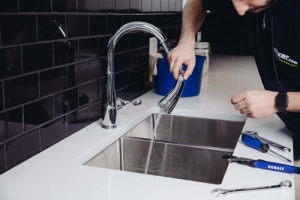Our Motives Behind Addressing a Dripping Faucet
Our Motives Behind Addressing a Dripping Faucet
Blog Article
They are making a number of great points on the subject of Why Is It Important To Fix Your Leaking Tap/Faucet? overall in this post beneath.

Leaking faucets could appear like a minor hassle, but their impact exceeds simply the aggravation of the noise. From wasting water to incurring unneeded monetary prices and health and wellness threats, neglecting a dripping faucet can bring about numerous consequences. In this write-up, we'll explore why it's essential to address this common family concern quickly and properly.
Wastage of Water
Environmental Influence
Trickling taps contribute dramatically to water wastefulness. According to the Environmental Protection Agency (EPA), a single tap leaking at one drip per secondly can throw away greater than 3,000 gallons of water per year. This not just stress water resources but additionally affects ecological communities and wildlife depending on them.
Financial Prices
Enhanced Water Bills
Beyond the environmental effect, dripping faucets can blow up water costs substantially. The built up wastage in time equates into higher utility costs, which might have been stayed clear of with timely fixings.
Potential Building Damages
Moreover, prolonged dripping can result in damage to fixtures and surfaces bordering the faucet. Water accumulation can cause staining, deterioration, and also architectural concerns if left ignored, leading to additional repair prices.
Wellness Issues
Mold and Mildew Growth
The consistent existence of moisture from a leaking tap creates a perfect setting for mold and mildew and mold development. These fungis not only jeopardize indoor air high quality yet also position wellness dangers, especially for individuals with respiratory system problems or allergic reactions.
Waterborne Conditions
Stationary water in dripping faucets can come to be a breeding place for microorganisms and various other virus, raising the risk of waterborne diseases. Pollutants such as Legionella microorganisms flourish in stagnant water, possibly leading to severe illnesses when consumed or breathed in.
Do it yourself vs. Professional Repair service
Advantages and disadvantages of Do It Yourself Repair Work
While some may attempt to fix a trickling tap themselves, DIY repairs feature their very own collection of difficulties. Without appropriate knowledge and devices, DIY efforts can exacerbate the problem or lead to incomplete repairs, prolonging the problem.
Benefits of Working With an Expert Plumber
Employing an expert plumber makes certain that the underlying source of the leaking tap is dealt with successfully. Plumbing professionals possess the knowledge and tools to detect and repair faucet concerns efficiently, saving time and lessening the threat of further damage.
Step-by-Step Guide to Repairing a Dripping Faucet
Devices Called for
Prior to trying to deal with a leaking tap, gather the required tools, including an adjustable wrench, screwdrivers, substitute parts (such as washers or cartridges), and plumber's tape.
Common Tap Issues and Their Solutions
Identify the kind of faucet and the details concern creating the drip. Usual issues include worn-out washers, rusty shutoff seats, or defective O-rings. Describe supplier guidelines or online tutorials for detailed advice on repairs.
Safety nets
Regular Upkeep Tips
To prevent dripping faucets, execute routine upkeep such as cleaning up aerators, evaluating for leakages, and replacing worn-out components quickly. Furthermore, take into consideration installing water-saving gadgets or updating to extra efficient components.
Importance of Prompt Services
Addressing leaking faucets as quickly as they're noticed stops more water waste and potential damages, ultimately saving both water and cash in the long run.
Effect On Home Value
Understanding of Well-Maintained Residential Property
Maintaining a building in good condition, including dealing with maintenance issues like trickling faucets, boosts its perceived value and value amongst potential buyers or tenants.
Influence on Resale Value
Residences with well-kept plumbing fixtures, including taps, command greater resale values in the real estate market. Addressing dripping faucets can contribute to a favorable impression throughout residential property assessments and arrangements.
Environmental Obligation
Private Payment to Conservation
Taking responsibility for dealing with dripping faucets lines up with wider initiatives towards water preservation and environmental sustainability. Every person's activities jointly make a significant impact on protecting precious sources.
Sustainable Living Practices
By prioritizing prompt fixings and adopting water-saving practices, people contribute to lasting living methods that benefit both existing and future generations.
Verdict
Resolving a trickling faucet goes beyond plain convenience; it's a vital step towards saving water, minimizing economic costs, and securing health and wellness and home. Whether with DIY repair work or specialist aid, taking action to repair trickling faucets is a small yet impactful method to advertise accountable stewardship of sources and contribute to a much healthier, a lot more lasting future.
How to Fix a Dripping or Leaky Faucet
A leaking faucet is one of the most common problems that homeowners encounter, but it being commonplace doesn’t make it any less annoying. The constant drip drip drip of a leaking bathtub faucet, showerhead, or sink tap can disturb your home’s serenity. Left neglected, a dripping faucet can also result in higher water bills and discoloration or mold growth in your sink or plumbing fixtures.
Fortunately, you don’t have to be a trained plumber to know how to stop a dripping faucet. With some basic tools, replacement parts, and a little patience, leaky faucet repair is a breeze. In this article, we’ll explain what causes dripping faucets and how you can fix them.
What Causes a Leaking Faucet?
Kitchen and bathroom faucets come in all manner of designs, but most involve some combination of valves, O-rings, seals, and washers. The O-ring is usually the weakest link, but any one of these pieces can wear down over time. Heat, moisture, temperature fluctuations, minerals, mold, and movement can contribute to warping and corrosion, breaking the watertight seal. This just comes with the territory of being a homeowner. Everything is always subject to wear and tear, and some component parts of your appliances and fixtures need to be replaced on occasion. At least replacement O-rings are cheap!
More rarely, dripping faucets can be a symptom of excessively high water pressure. Were this the case in your home, you would probably notice that the leak is not isolated to one faucet. Water pressure issues are harder to resolve on your own. We recommend contacting a professional plumber if you suspect your water pressure is too high.
How to Fix a Dripping Faucet
Pipe wrench or monkey wrench Allen wrench set Screwdrivers Old towel or rag Shut off the water.
Before you do anything, you need to turn off the water to keep from drenching your kitchen or bathroom. You should find a valve under the sink and against the wall. Once you’ve turned this valve, try turning the faucet on to confirm that the water source has been cut off.
If you can’t locate your local valve for the faucet you’re working on, you can always shut off the water to the house at the main valve. Of course, this will prohibit anyone from using the sinks, showers, or toilets while you’re working on the faucet that’s giving you trouble.
Plug or block the drain.
You’ll be disassembling the faucet and removing some small bits of hardware. Plug the drain with a stopper or rag to avoid the possibility of a small screw falling into your P-trap.
Take apart the faucet assembly.
There are several varieties of kitchen and bathroom faucets, each with its own manner of assembly. For detailed instructions on how to disassemble your faucet, you can refer to the fixture’s manual or contact the manufacturer. If you know whether you have a ball, disc, cartridge, or compression faucet, you can find detailed schematics online.
In general, you need to begin by removing the faucet handles. You might notice a small screw that you’ll need to remove with a screwdriver or Allen wrench. If you don’t see any visible securing hardware, it’s likely hidden under a decorative cap that can be unscrewed or popped off with flathead screwdriver.
Remove each piece methodically, consulting a schematic when necessary. Take notes or arrange the pieces in such a way to make it easier to correctly reassemble the faucet later.
Remove the cartridge.
Once you’ve removed the handles and securing hardware, you should be able to remove the valve cartridge or stem. Some cartridges will slide right out. Other faucet models will require you to loosen a nut with a pipe wrench before you can remove the valve stem.
Examine the exposed hardware.
With the cartridge or stem removed, inspect the component parts. Check the rubber O-rings for wear and tear. Also examine the seat washer for corrosion or other damage. These pieces are usually the responsible parties for a dripping faucet, but it’s worth inspecting the other component parts while you have the faucet disassembled.
Find replacement parts.
Once you’ve identified which faucet component has failed, find an identical replacement. Your local hardware store should have O-rings, seat washers, and other standard components in stock. If you have a luxury or uncommon faucet, you may have to contact the manufacturer for a replacement part.
It’s a good idea to take your old parts with you to the hardware store so you can compare them with the store’s inventory and be sure you’re purchasing the correct replacement.
Reassemble the faucet.
With your new parts in hand, reconstruct the faucet and handles. Don’t be tempted to overtighten screws or nuts. You might think this could create a better seal, but it can instead damage or bend a delicate part of the assembly and create a new problem for you.
Turn on the water and test the faucet.
The only thing left to do is test your work. Unplug the sink, turn the water back on, and try the faucet. Congratulate yourself on a job well done!
https://www.libertyhomeguard.com/how-to-fix-a-dripping-or-leaky-faucet/

Do you appreciate more info about Leaky Faucets: Why They Happen & What to Do About Them? Give a remark down the page. We would be pleased to hear your thoughts about this review. In hopes that you visit us again in the future. Appreciated our content? Please share it. Help other people locate it. We enjoy your readership.
Report this page